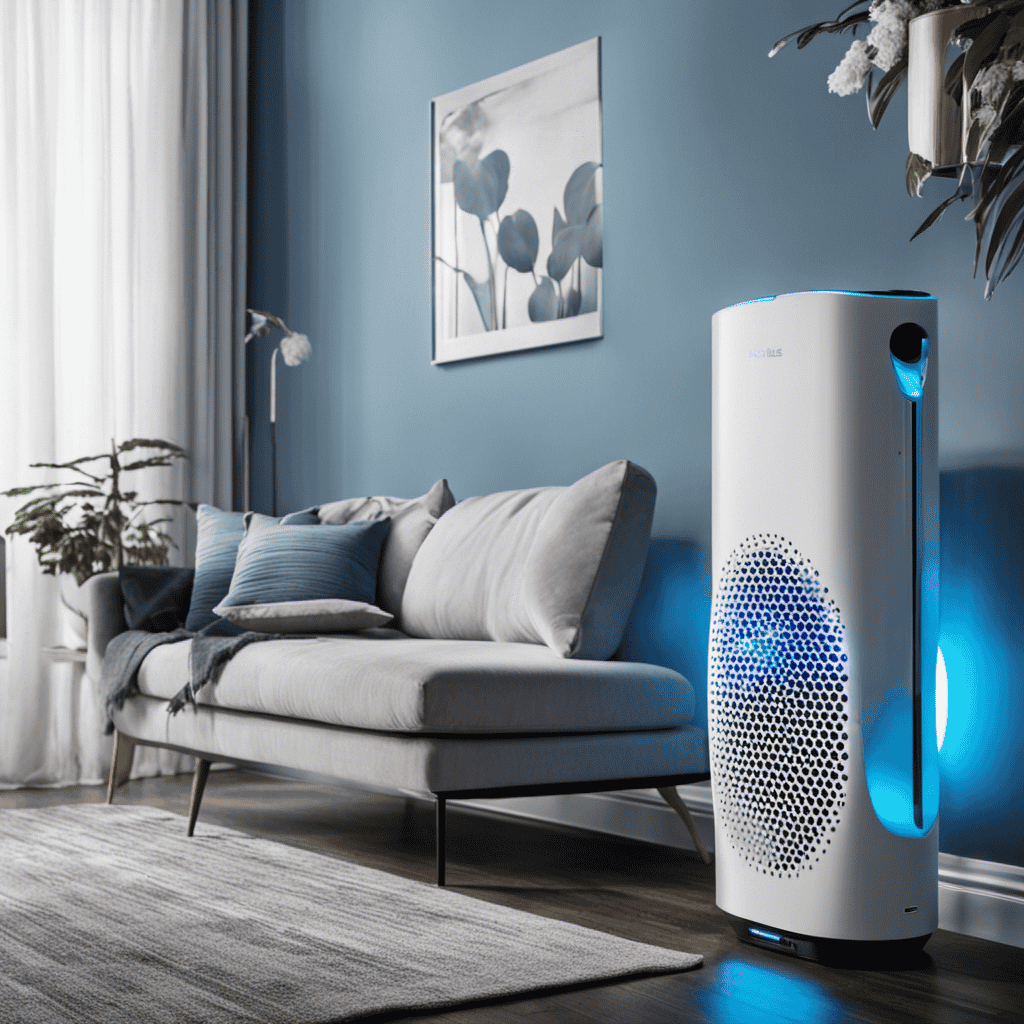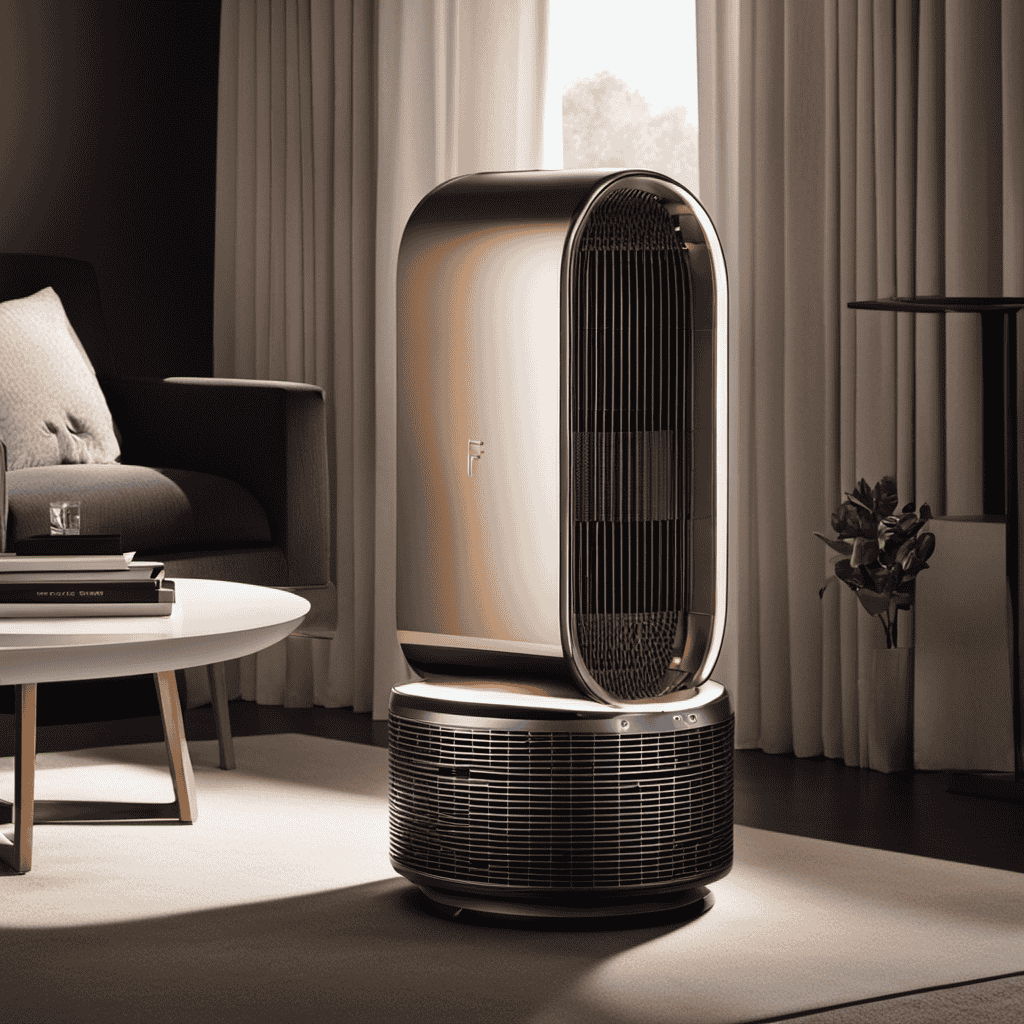Being a person with severe allergies, I have always been curious about the invention of air purifiers. What prompted the creation of these devices that claim to enhance indoor air quality?
In this article, we will delve into the historical background of air purifiers, explore the early concerns about air pollution, and analyze the technological advancements that have shaped their design.
By understanding the reasons behind their invention, we can better appreciate the health benefits they provide and explore their potential in creating a sustainable environment.
Key Takeaways
- Air purifiers were invented in response to concerns about air pollution in urban areas, particularly due to industrialization and rapid growth of cities.
- Technological advancements, such as the invention of filters, ionizers, and electrostatic precipitators, played a crucial role in the development of air purifiers.
- Early air purifiers utilized basic filtration methods like fabric or charcoal, which laid the foundation for more sophisticated air purification systems.
- Air purifiers have a significant impact on indoor air quality by effectively removing common pollutants like dust, pollen, pet dander, and odors, improving overall well-being.
Historical Background of Air Purifiers
Air purifiers were invented in the early 20th century in response to concerns about air pollution in urban areas. Industrialization and the rapid growth of cities led to increased levels of air pollution, causing health issues for residents. The early air pollution was primarily caused by burning fossil fuels, industrial emissions, and inadequate waste management. Technological advancements played a crucial role in the development of air purifiers. Scientists and engineers worked to create devices that could effectively remove pollutants from the air. These advancements included the invention of filters, ionizers, and electrostatic precipitators, which captured and eliminated harmful particles and chemicals. The early air purifiers paved the way for the modern devices we use today, providing cleaner air and improving quality of life for many people.
Early Air Pollution Concerns
Back in the early days, people started to worry about their health because they couldn’t escape the smog and pollution that filled the air. The increase in industrialization and urbanization led to the release of harmful pollutants into the atmosphere, causing serious public health concerns.
As a result, governments around the world recognized the need for air pollution regulation to protect the well-being of their citizens. These regulations aimed to control emissions from industries, vehicles, and other sources, in order to improve air quality and reduce the health risks associated with pollution.
The introduction of air purifiers was a direct response to these concerns. These devices were designed to filter out harmful particles and chemicals from indoor air, providing people with a safer and cleaner environment.
Today, air purifiers continue to play a crucial role in improving indoor air quality and protecting public health.
Development of Filtration Technology
The historical origins of filters can be traced back to the early civilizations that recognized the importance of clean air. Ancient Egyptians, for example, used charcoal filters to purify their drinking water.
Over time, the development of filtration technology evolved to address the growing concerns of indoor air pollution. Filters have had a significant impact on indoor air quality by capturing and removing various contaminants, such as dust, pollen, and smoke particles, thereby creating a healthier environment for occupants.
Historical Origins of Filters
Did you know that air purifiers were invented in the early 1800s to combat the harmful effects of industrial pollution in the cities?
The historical significance of these early innovations cannot be overstated. As industrialization took hold, the rapid growth of factories and coal-burning industries led to the release of toxic pollutants into the air, causing widespread health issues.
Recognizing the need for a solution, inventors began developing air purifiers to filter out these pollutants and improve air quality. These early air purifiers utilized basic filtration methods, such as using fabric or charcoal to trap particles and odors.
While these early innovations may seem rudimentary compared to today’s advanced technology, they laid the foundation for the development of more sophisticated air purification systems.
Transitioning into the impact on indoor air, let’s explore the advancements that have been made in recent years.
Impact on Indoor Air
Nowadays, it’s incredible how advanced air purification systems have become, making a significant impact on indoor air quality. Air purifiers are highly effective at removing common indoor air pollutants such as dust, pollen, pet dander, mold spores, and even certain volatile organic compounds (VOCs). These pollutants can cause respiratory issues, allergies, and other health problems.
The effectiveness of air purifiers in removing these pollutants is determined by factors such as the type of filter used, the size of the unit, and the airflow rate. HEPA filters, for instance, are known for their high efficiency in capturing particles as small as 0.3 microns. With the advancement of technology, air purifiers now come with features like activated carbon filters, UV-C light, and ionizers, enhancing their effectiveness even further.
Transitioning into the subsequent section about the role of allergies and asthma, air purifiers play a crucial role in alleviating symptoms and providing relief to those suffering from these conditions.
The Role of Allergies and Asthma
As someone who suffers from allergies and asthma, I’ve always been interested in finding ways to alleviate my respiratory symptoms.
In my research, I’ve come across the topic of air purifiers and their potential health benefits.
I’m excited to delve deeper into this discussion and explore how air purifiers can help in alleviating respiratory symptoms such as allergies and asthma.
Health Benefits of Purifiers
One of the main reasons air purifiers were invented was to help improve people’s health. Indoor pollutants can have a detrimental effect on our respiratory system, leading to the development of various respiratory diseases. Air purifiers work by filtering out these pollutants, providing cleaner air for us to breathe.
Here are some health benefits of using air purifiers:
-
Reduction of allergens: Air purifiers can remove common allergens such as dust mites, pollen, and pet dander from the air, reducing the risk of allergic reactions.
-
Elimination of harmful chemicals: Certain air purifiers are designed to remove volatile organic compounds (VOCs) and other harmful chemicals, promoting a healthier indoor environment.
-
Prevention of respiratory diseases: By removing airborne pollutants, air purifiers can help prevent the onset or exacerbation of respiratory diseases such as asthma and chronic obstructive pulmonary disease (COPD).
Alleviating Respiratory Symptoms
Using air purifiers can help alleviate respiratory symptoms by removing airborne pollutants that can trigger asthma and other respiratory conditions. When it comes to respiratory relief, different purification methods are available to suit various needs. Let’s take a look at the table below to understand the different purification methods and their effectiveness in providing respiratory relief.
| Purification Method | Description | Effectiveness |
|---|---|---|
| HEPA | High-Efficiency Particulate Air filters that capture small particles such as dust, pollen, and pet dander. | Highly effective in removing allergens and other airborne particles. |
| Activated Carbon | Absorbs odors, chemicals, and gases from the air. | Effective in eliminating odors and chemical pollutants. |
| UV-C | Uses ultraviolet light to kill bacteria, viruses, and mold spores. | Effective in reducing microbial contaminants in the air. |
Air Purifiers for Indoor Air Quality
To improve the quality of the air you breathe indoors, you should consider using an air purifier. Air purifiers are designed to remove pollutants and allergens from the air, making it cleaner and healthier to breathe. Here are three reasons why air purifiers are beneficial for indoor air quality:
- Air purifiers can help remove pet dander and hair, reducing the risk of allergies and asthma symptoms for pet owners.
- Air purifiers can capture and filter out airborne allergens such as pollen, dust mites, and mold spores, providing relief for individuals with allergies.
- Air purifiers can also help eliminate odors and airborne particles from cooking, smoking, or chemical pollutants, creating a fresher and more pleasant indoor environment.
By investing in an air purifier, you can create a cleaner and healthier living space for yourself and your loved ones, improving overall well-being.
However, it is important to recognize that air pollution is not limited to indoor settings. The impact of industrialization on air quality has far-reaching effects, which we will explore in the next section.
Impact of Industrialization on Air Quality
Industrial pollution has had a significant impact on air quality, leading to its degradation and the need for air purification.
The emissions released by industries contain harmful pollutants such as sulfur dioxide, nitrogen oxides, and particulate matter, which can have detrimental effects on human health and the environment.
As a result, air purification technologies have become essential in order to remove these pollutants and improve the overall air quality in industrialized areas.
Industrial Pollution’s Effects
You can’t ignore the detrimental effects of industrial pollution on your health. Industrial pollution, caused by the release of harmful chemicals and pollutants into the environment, can have serious consequences for both human health and the ecosystem. Here are some key points to consider:
- Industrial pollution can lead to respiratory problems such as asthma and bronchitis.
- Exposure to industrial pollutants can increase the risk of developing cardiovascular diseases.
- Industrial pollution can also contaminate water sources, leading to waterborne diseases and ecosystem disruption.
To mitigate the harmful effects of industrial pollution, air pollution control measures have been implemented. These include the use of pollution control technologies, such as scrubbers and filters, to reduce emissions from industrial processes. Additionally, stricter regulations and monitoring systems have been put in place to ensure compliance with environmental standards.
As industrial pollution continues to pose a threat to our health and environment, it is crucial to address the issue of air quality degradation and find sustainable solutions to mitigate its impact.
Air Quality Degradation
After learning about the detrimental effects of industrial pollution on air quality, let’s delve into the causes and explore the effectiveness of air purifiers in combating this issue. Air pollution arises from various sources, including industrial emissions, vehicle exhaust, and the burning of fossil fuels. These activities release harmful pollutants such as particulate matter, nitrogen oxides, and volatile organic compounds into the atmosphere. These pollutants can have severe health effects, including respiratory issues and cardiovascular diseases. To mitigate these risks, air purifiers have been invented. These devices work by filtering and purifying the air, removing harmful particles and pollutants. While the effectiveness of air purifiers varies depending on the specific model and the pollutants present, they can significantly improve indoor air quality, making them a valuable tool in combating air pollution.
| Air Pollutants | Air Purifier Effectiveness |
|---|---|
| Particulate Matter | Highly Effective |
| Nitrogen Oxides | Moderately Effective |
| Volatile Organic Compounds | Varies depending on the model |
Need for Air Purification
The causes of air pollution include various activities such as vehicle exhaust and burning fossil fuels, which release harmful pollutants into the atmosphere. Indoor pollutants also contribute significantly to air pollution. These pollutants can come from sources like tobacco smoke, cooking fumes, and building materials.
To address the issue of air pollution and improve indoor air quality, air purifiers were invented. These devices are designed to filter out pollutants and improve the air we breathe. They work by using filters to capture particles such as dust, pollen, and smoke, as well as harmful gases and chemicals.
Air purifiers play a crucial role in air pollution control, helping to reduce the impact of indoor pollutants on our health and well-being.
Health Benefits of Using Air Purifiers
Using an air purifier can help reduce the presence of allergens and pollutants in your home, improving the overall air quality.
Air pollution is a significant concern in many areas, and it can have detrimental effects on our health. When we breathe in polluted air, we expose ourselves to various particles and chemicals that can cause respiratory issues, allergies, and even long-term health problems.
Air purifiers work by capturing and removing these harmful substances from the air, ensuring that we breathe cleaner and healthier air.
By reducing the presence of allergens, such as dust mites, pollen, and pet dander, air purifiers can provide relief for individuals with allergies or asthma.
Additionally, they can help to eliminate harmful pollutants, such as volatile organic compounds (VOCs) and smoke particles, which can have negative effects on our respiratory and cardiovascular systems.
Overall, using an air purifier can have significant health benefits by improving the air quality in our homes and reducing our exposure to harmful pollutants and allergens.
Air Purifiers in Commercial and Residential Settings
Air purifiers can be beneficial in both commercial and residential settings. They help improve air quality and reduce exposure to harmful pollutants and allergens.
In commercial use, air purifiers are essential for maintaining a healthy work environment and ensuring the well-being of employees. They can effectively remove airborne particles such as dust, pollen, and mold spores, which can cause respiratory issues and allergies. Air purifiers also eliminate unpleasant odors, creating a more pleasant and productive atmosphere.
In residential use, air purifiers are particularly important for individuals with allergies, asthma, or other respiratory conditions. They provide relief by filtering out allergens, pet dander, and tobacco smoke. Air purifiers also help create a clean and fresh living space for families, promoting overall health and well-being.
Technological Advancements in Air Purifier Design
You’ll be amazed at the new features and capabilities of modern air purifier designs. Technological advancements have revolutionized air purification techniques, allowing for more efficient and effective removal of pollutants from indoor environments. These advancements include the use of high-efficiency particulate air (HEPA) filters, activated carbon filters, and electrostatic precipitators.
HEPA filters are capable of capturing particles as small as 0.3 microns, ensuring cleaner and healthier air. Activated carbon filters are designed to remove odors and harmful chemicals from the air, while electrostatic precipitators use an electrical charge to trap particles. Additionally, many air purifiers now come equipped with smart sensors and Wi-Fi connectivity, allowing for remote control and monitoring.
These advancements have made air purifiers an essential tool in improving indoor air quality and promoting a healthier living environment.
With the ever-increasing concerns about environmental sustainability, the future of air purifiers lies in the development of more eco-friendly and energy-efficient models. As we strive to reduce our carbon footprint, manufacturers are exploring alternative materials and design strategies that minimize waste and energy consumption. Additionally, there is a growing focus on incorporating renewable energy sources, such as solar power, into air purifier systems.
Furthermore, advancements in nanotechnology hold promise for the development of more compact and efficient air purification technologies. By continuously innovating and improving, the future of air purifiers aligns with our commitment to a greener and more sustainable world.
Future of Air Purifiers and Environmental Sustainability
As we explore the future of air purifiers, it is evident that innovative advancements and renewable technologies will play a crucial role in enhancing environmental sustainability. Here are some key points to consider:
-
Integration of Artificial Intelligence (AI): AI algorithms will be used to optimize air purifier performance, allowing them to adapt to changing environmental conditions and provide real-time data on air quality.
-
Energy-efficient Designs: Future air purifiers will focus on reducing energy consumption through the use of low-power electronics, energy-efficient fans, and advanced filtration systems.
-
Integration with Renewable Energy Sources: Air purifiers will be designed to operate on renewable energy sources such as solar or wind power, reducing their carbon footprint and dependency on fossil fuels.
These future innovations in air purifiers will not only improve indoor air quality but also contribute to a more sustainable and eco-friendly future.
What is the Function of the Blue Button on an Air Purifier and How Does It Relate to Its Invention?
The blue button on an air purifier is essential for controlling its functionality. It allows users to adjust settings, such as fan speed or power, and activate certain modes like sleep or auto. This innovation contributes to the convenience and effectiveness of air purifiers in creating cleaner and healthier indoor air.
Frequently Asked Questions
How Do Air Purifiers Work to Remove Pollutants From the Air?
Air purifiers work by filtering the air and trapping pollutants like dust, pollen, and pet dander. They help improve indoor air quality, reducing allergies and providing cleaner air to breathe.
What Are the Different Types of Air Purifiers Available in the Market?
There are various types of air purifiers in the market. Some top-rated options include HEPA filters, activated carbon filters, and ionizers. Using air purifiers can provide numerous benefits, such as reducing allergens and improving indoor air quality.
Can Air Purifiers Completely Eliminate All Types of Air Pollutants?
Yes, air purifiers can eliminate many types of air pollutants. However, they may not be able to completely eliminate all pollutants. The future of air purification technology holds promise for more effective solutions.
Are Air Purifiers Effective in Reducing the Spread of Airborne Viruses and Bacteria?
Yes, air purifiers are effective in reducing the spread of airborne viruses and bacteria. They play a crucial role in improving indoor air quality for respiratory health and reducing allergies and asthma symptoms.
How Often Should Air Purifier Filters Be Replaced for Optimal Performance?
Regular maintenance is crucial for optimal air purifier performance. Signs of filter replacement include decreased airflow and odors. Neglecting maintenance compromises air quality. Filters should be replaced according to manufacturer guidelines to ensure effectiveness.
Conclusion
In conclusion, the invention of air purifiers has revolutionized the way we breathe and live.
These remarkable devices have come a long way since their early beginnings, driven by concerns about air pollution and the need for cleaner indoor air.
With advancements in filtration technology and a better understanding of allergies and asthma, air purifiers have become essential for improving indoor air quality and promoting better health.
As we look to the future, it is crucial to continue developing sustainable air purifiers that contribute to a healthier environment.










